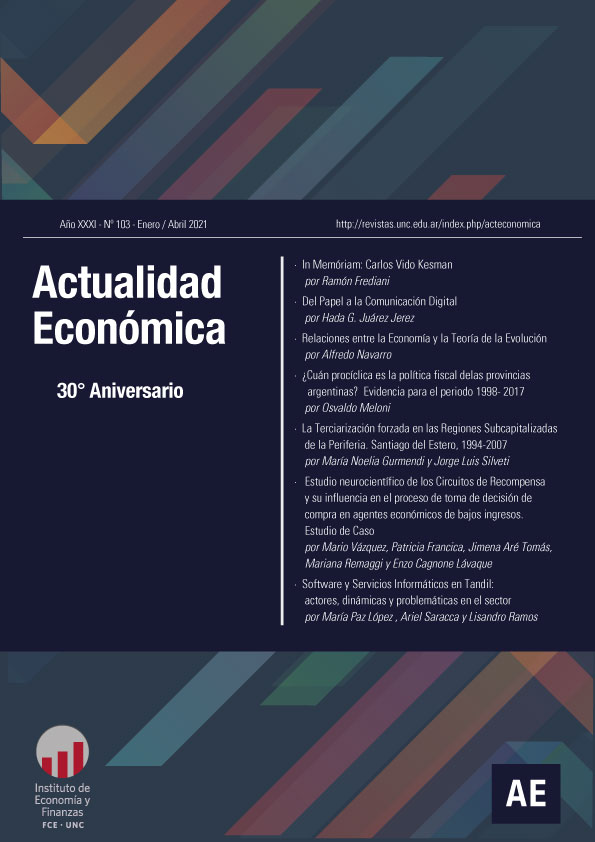Forced Terciarization in the Subcapitalized Regions of the Periphery. Santiago del Estero, 1994-2007
Keywords:
forced tertiarisation, productive sectors, average productivity, Santiago del EsteroAbstract
In the present study, it shows the particular aspects of the transition from a subcapitalized region to a peripheral country. The dynamics of the productive structure is analyzed through the application of a method of descriptive statistics, known as the "Fabricant formula". The variable on which the analysis revolves is the average productivity of labor, addressed by the productive sector. The results obtained reveal the circuits that help to understand the functioning of this type of postponed regions, which lost the path of sustained and stable growth.
Downloads
References
CEPAL. (2007). Progreso técnico y cambio estructural en América Latina. Santiago de Chile.: CEPAL, Documento de trabajo, Nº 136 (LC/W.136).
CEPAL. (2014). Pactos para la igualdad. Hacia un futuro sostenible. Lima: CEPAL.
CFI. (2008). Producto Bruto Provincial. Santiago del Estero: 1994-2007. CABA: Consejo Federal de Inversiones.
DGIEyC. (1983). Anuario Estadístico de Santiago del Estero. Santiago del Estero: Dirección General de Investigaciones, Estadística y Censos del Ministerio de Economía de Santiago del Estero.
Di Filippo, A. (2009). Estructuralismo latinoamericano y teoría económica. Revista de la CEPAL N° 98.
Escaith, H. (octubre de 2006). Industrialización truncada y terciarización sustitutiva en América Latina. (U. N. Méjico, Ed.) Problemas del desarrollo.Revista latinoamericana de economía., 37(147), 45-80.
Ferrer, A. (1963). La economía argentina. Las etapas de su desarrollo y problemas actuales. Argentina: Fondo de Cultura Económica.
Guillén Romo, H. (2005). Auge, declinación y renacimiento de la economía anglosajonaestándar del desarrollo. Mundo Siglo XXI, 18-28.
INDEC. (1999). Estadísticas básicas. Los municipios de Santiago del Estero. CABA: INDEC.
Lewis, W. A. (1954). Economic Development with Unlimited Supplies of Labour. The Manchester School, 28(2).
Maddison, A. (1952). Productivity in an expanding economy. Economic Journal, 584-594.
Rostow, W. W. (1961). Las etapas del crecimiento económico: Un manifiesto no comunista. Méjico: Fondo de Cultura Económica.
Silveti, J. L. (2015). Brechas productivas y disparidades territoriales. el mapa de las privaciones en Santiago del Estero, 1990-2010. En F. d. Humanidades, La investigación en la Facultad de Humanidades (págs. 321-345). Santiago del Estero: Idearte Gráfica.
Silveti, J. L., & Gurmendi, N. (2017). Dinámica de la Estructura de Empleo: sectores productivos, categorías ocupacionales y ciclos económicos en Santiago del Estero, 1994-2007. Asociación Argentina de especialistas en estudios del trabajo. Buenos Aires: 13º Congreso Nacional de Estudios del Trabajo.
Silveti, J. L., Gurmendi, N., & Salvatierra, R. (2017). Cambio estructural y desarrollo productivo en Santiago del Estero: 1994-2007. Trabajo y sociedad(29), 377-390.
Silveti, J., & Gurmendi, N. (julio de 2018). Neoestructuralismo: igualdad, cambio estructural y desarrollo en el capitalismo periférico. e-l@tina, 16(64), 19-32.
Solow, R. M. (febrero de 1956). A contribution to the Theory of Economicf Grrowth. Quarterly Journal of Economics, 70(1).
Downloads
Published
Issue
Section
License

This work is licensed under a Creative Commons Attribution-NonCommercial-NoDerivatives 4.0 International License.
Those authors who have published with this journal, accept the following terms:
Authors will conserve their copyright and guarantee the magazine the right of first publication of their work, which will be simultaneously subject to the Creative Commons Attribution-NonCommercial-NoDerivative 4.0 International License that allows third parties to share the work as long as the author and first publication of this magazine are indicated.
Authors may adopt other non-exclusive license agreements to distribute the published version of the work (e.g., deposit it in an institutional telematic archive or publish it in a monographic volume) provided that the initial publication in this journal is indicated.
Authors are allowed and encouraged to disseminate their work through the Internet (e.g., in institutional telematic archives or on their website) before and during the submission process, which may lead to interesting exchanges and increase citations of the published work. (See The effect of open access)









